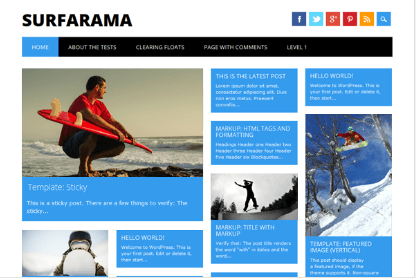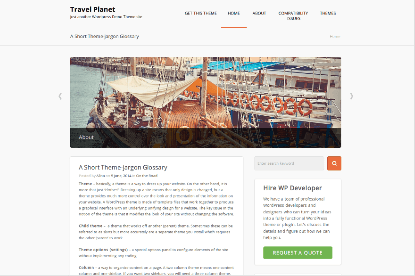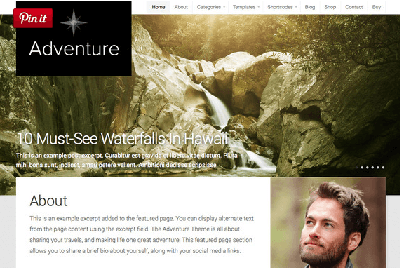This article goes into the details of how to start a travel blog. For this article to make sense you should at least have your blog software installed first. If you don’t, check out my free blogging tutorial, and then come back to this article later.
As traveling becomes ever more affordable to the masses, it shouldn’t come as any surprise that it is already one of the hottest blogging niches on the internet. However, while almost anyone can become a travel blogger by sharing stories and tips from their adventures, only a few succeed in reaching out to more than a small audience of friends and family. If you want to become a superstar in the world of travel blogging to the extent that you can earn a respectable income from on-site advertising and relevant affiliate programs, you’re going to need to plan carefully and invest a lot of time in the project.
Given the amount of competition, maintaining a successful travel blog can take some time. If you want to turn your blog into an earner in the future, there are plenty of important considerations to take to heart.
Why Start a Travel Blog Now?
Travel continues to be a growing niche, and while many will say the market is saturated, this is only true in certain areas. Fortunately, travel is a broad subject covering a range of styles, budgets, methods and, of course, geographical locations. By focussing on a specific topic, you’ll be able to reach out to a small but engaged audience. There remains plenty of opportunity to fill a hole in the market, and the world isn’t as small as many people think. The travel and tourism industry continues to evolve as people seek out local experiences and adventure travel makes a comeback like never before. Pop-culture tourism and travel to up-and-coming destinations are also broader than ever, making certain areas of the niche potentially very lucrative.
Who Should Become a Travel Blogger?
Keeping a successful travel blog is not just about sharing your own experiences with the rest of the world. After all, anyone can blog about their adventures, but reaching out to a wider audience requires a rather different approach as well as a lot of hard work. Most importantly, you’ll need to be prepared to invest a lot of time and effort in your blog, and you’ll also need to be consistently active in the travel scene in order to have enough original and engaging material to write about. You’ll also need to prepare for change when it comes to traveling itself, since the clichéd image of a travel writer relaxing on a beach with a laptop is far from accurate in reality. To have any hope of success, you’ll need to learn to balance your time spent getting to know new places with actually working on your blog.

Cartoon by Dave Walker.
Regarding the technicalities involved in starting a travel blog, such as registering a domain name and setting up your content management system (CMS), travel blogging is little different to working with any other niche. However, there are some unique aspects with regards to building and maintaining a successful blog. For a start, travel is a visual topic that relies heavily on quality imagery and video content as well as a creative and personalized blog design. Travel blogging also requires plenty of first-hand knowledge of the type that builds up trust and rapport to the extent your audience will readily approach you for advice. Travel is also one of the hottest topics of conversation, making social media integration and on-site comments critical components of any travel blogging project.
How to Start a Travel Blog
Before you even register a domain name, you’ll want to decide on a specific niche to write about, and it will need to be one that you have a genuine passion for as well as plenty of experience in to get started. Whether your focus is on volunteering experiences, solo travel or luxury travel, you’ll need to narrow it down as much as possible. If you can combine it with another popular topic, such as food or extreme sports, then you’ll have even more chance of standing out among the competition.
When you’ve decided on a niche and you know what you want to start writing about, it will be time to register a domain name. To have any chance of success, you’ll need your own website, preferably with a .com extension. Make your domain name short, catchy and easy to remember. When registering your Web address, consider getting your hosting package through the same company, preferably one offering a one-click WordPress installation. WordPress is the go-to CMS for bloggers, since it provides everything you need for easy customization and content publication without having to know anything about the inner workings of Web design or coding. It’s also open-source and free, and there are countless plugins and themes available.
Many of the major hosting companies, such as Bluehost, provide a one-click WordPress installation that will allow you to have your blog up and running in a matter of minutes. Your website will be live immediately, but until you have decided on the theme and layout and published one or two posts, you may want to use a plugin such as WP Construction Mode to block access to your blog until it’s ready. Once you’ve registered your domain name and got WordPress up and running, you’ll be ready to start customizing your blog with different themes and plugins.
Recommended Themes for Your Travel Blog
With around 10,000 themes available for WordPress, choosing the right one might seem like an impossible task, but there are a few important considerations to help you narrow down your search:
• Responsive themes allow your website to look great on smartphones as well.
• Themes with large headers allow you to display an eye-catching travel image.
• Flat and minimalist designs tend to be more user-friendly and customizable.
If you find yourself stuck trawling through the enormous number of themes available for WordPress, take a look at the following for some inspiration:
Travelify
Travelify features a responsive design and many additional customization options. However, what makes it a particularly great choice for a travel blog is the way it showcases your content, starting with the opportunity to place a high-resolution header image to capture your reader’s attention.
Surfarama
Using a popular tile-based layout that looks particularly great on touch-screen devices such as tablets and smartphones, Surfarama is a great choice for magazine-style travel blogs that are heavily reliant on imagery. It also provides many customization options, including the ability to choose a background image.
Travel Planet
Featuring a clean and minimalistic design with plenty of whitespace to help accentuate a carefully chosen header image, Travel Planet is suitable for almost any travel blog. In niches where visual content is often the main attraction, this lesser-known theme will bring your blog to life without overshadowing your written content.
Adventure Theme
Adventure Theme costs $69, but it provides many features and an impeccable layout. It’s retina-optimized, fully responsive, and it sports a slideshow showcasing your most popular articles. Designed exclusively for travel blogs, it’s an excellent choice for presenting your content in a professional manner.
Accelerate
A popular, multipurpose free theme with outstanding ratings and reviews, Accelerate features a clean, flat design with an emphasis on visual content. It is fully responsive, and your favourite posts may be proudly displayed on your front page in the form of eye-catching thumbnail previews.
Recommended Plugins for Your Travel Blog
Plugins add more functionality to your blog, and any blog should have a few installed. However, it is also important that you choose your plugins carefully, since having too many can slow down your website and make it harder to maintain. In addition to general must-have plugins such as WordPress SEO by Yoast, W3 Total Cache and Google XML Sitemaps, there are a few plugins that are particularly useful for those that want to be travel bloggers:
WP Smush.it
Travel blogs are heavily reliant on images, particularly large and colourful ones that capture the attention as soon as someone lands on the page. Unfortunately, these images can take up a lot of bandwidth, slowing down your site in the process. However, this plug-in will automatically optimize and compress your image content.
Shadowbox
Another useful plugin for photo-heavy travel blogs, Shadowbox allows your visitors to view images in a far more engaging way by enlarging the image and dimming the background when someone clicks on a thumbnail preview. Visitors can also view multiple images in a single post using a convenient slideshow.
Nomad Word Map
When blogging about your travels, there’s no better way to illustrate your adventures than by creating a customized map pinpointing the place’s you’ve been to. Nomad World Map allows you to add multiple locations to a map and link related blog posts to each point.
WP World Travel
WP World Travel is a premium plugin for travel blogs that displays your current location, travel plans and proposed meetups in each destination. The customizable plugin may be placed as a sidebar widget so that is visible on every page of your blog.
Final Words
To succeed with travel blogging, you’re going to need to market your efforts using social media, particularly with regards to visual platforms like Instagram, Flickr and Pinterest. You’ll need to maintain an active presence on social media by sharing eye-catching photos that truly capture the essence of your written work. As such, travel bloggers will also need to work on their photography skills to complement their posts and marketing efforts.





